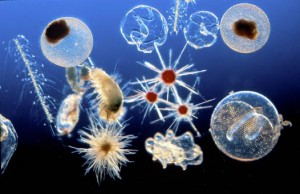The world’s oceans have long fascinated humankind. From our earliest origins, the vast spectrum of marine wildlife have captured the imaginations of sailors and land lubbers alike, and most people have their favourite animal in the ocean; Whales, dolphins, sharks, seals and turtles almost always top the list for visitors to tourism hotspots. Other species, such as tuna, halibut, and monkfish are favourites in culinary circles, while sport and big-game fishing enthusiasts will voice their preference for marlin, sailfish and tarpon. But there is, however, a class of animal that none of these other species could live without, as it is the basis for all marine life in our world’s oceans: plankton.
Floating endlessly in the water column in every large body of water on the planet are microscopic organisms, without which there would be very little life in the world’s oceans. Plankton is the building block of all marine and freshwater ecosystems, and comprises the founding layer of all aquatic food chains. The term “Plankton” is actually an umbrella term for a large variety of microscopic animals, protists, archaea, algae, and bacteria that inhabit the pelagic zone of oceans, seas, and bodies of fresh water. Plankton are actually classified by the role they play in nature as a primary producer, rather than by their biological or physiological characteristics, and are divided into three main categories: Phytoplankton, which are various types of plants and algae that live near the water surface where there is sufficient light to support photosynthesis. Zooplankton are small protozoans, crustaceans and other animals that feed on other plankton. Some of the eggs and larvae of larger animals such as fish, crustaceans and invertebrates are included here. The last category is bacterioplankton, which are various types of bacteria, which play an important role in re-mineralising organic material down the water column.
These organisms are vital for the marine ecosystem because they are what are known as primary producers—they are at the very bottom of aquatic food chains, and without them, all other organisms could not exist. Plankton are the primary food source of many species of fish larvae, barely visible to the naked eye, as well as larger animals such as Manta Rays. Larger animals also directly eat plankton as a primary food source, including basking sharks and whale sharks, the largest fishes in the ocean, as well as many species of whales. Fish larvae eating plankton are, in turn, fed upon by successively larger species of fish; if this system collapses all of the big-game and iconic species come under threat. Indeed, as fisheries worldwide adapt to climate change and the threat of overfishing, the impact of imbalances in plankton populations can potentially have enormous consequences on Marine Ecosystems.
So now that you know a little bit about the building blocks of the marine environment, what steps can you take to ensure the viability of various species for future generations? The best option is choosing sustainable seafood. The most helpful step? Ask before you buy—One of the most important ways to help improve the sustainability of our seafood is to ask questions when you buy your seafood, whether it’s at a restaurant, grocery store, or from a fish monger. “Is the species overfished?” “How was it caught or farmed?” and “Where is it from?” are all excellent questions to help you determine the sustainability of a particular fish.

